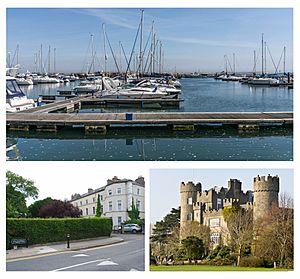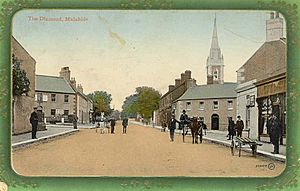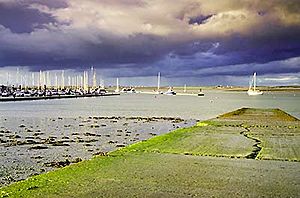Malahide facts for kids
Quick facts for kids
Malahide
Mullach Íde
|
|
|---|---|
|
Suburb (village core)
|
|

Clockwise from top: Malahide marina; Malahide Castle; period terraced houses in central Malahide
|
|
| Country | Ireland |
| Province | Leinster |
| County | Dublin |
| Administrative County | Fingal |
| Dáil Éireann | Dublin Fingal |
| European Parliament | Dublin |
| Elevation | 3 m (10 ft) |
| Population
(2022)
|
|
| • Urban | 18,608 |
| Time zone | UTC±0 (WET) |
| • Summer (DST) | UTC+1 (IST) |
| Eircode routing key |
K36
|
| Telephone area code | +353(0)1 |
Malahide is a lively coastal town in Fingal, County Dublin, Ireland. It's located about 9 kilometers (6 miles) north of Dublin city.
Malahide has a charming village center surrounded by modern homes. In 2022, its population was 18,608 people.
One of its most famous landmarks is Malahide Castle, which dates back to the 12th century. The castle is surrounded by a huge park, which even includes an international cricket ground! The area also boasts a beautiful sandy beach, a marina for boats, and many sports clubs.
Contents
- What's in a Name? The Meaning of Malahide
- Where is Malahide? Location and Travel
- A Look Back: Malahide's History
- How Malahide is Governed
- Fun Things to Do: Leisure and Clubs
- Sports Teams in Malahide
- Learning in Malahide: Education
- Places of Worship: Religion
- Getting Around: Transport
- Famous Faces: People from Malahide
- See also
What's in a Name? The Meaning of Malahide
The name Malahide comes from "Mullach Íde" in Irish. This might mean "the hill of Íde" or "Íde's sand-hill." It could also refer to a Norman family called the Hydes who lived in the area.
Another idea is that Malahide comes from "Baile Átha Thíd," meaning "the town of the ford of Thíd." A ford is a shallow place in a river where you can cross. This ford might have been at the mouth of the Gaybrook Stream.
Where is Malahide? Location and Travel
Malahide is located north of Dublin city, between the towns of Swords, Kinsealy, and Portmarnock. It sits on the southern shore of an estuary, which is where the Broadmeadow River meets the sea.
You can easily get to Malahide by public transport. The DART train service connects Malahide to Dublin city and other coastal towns. Several Dublin Bus routes also serve the town, including express services during busy times.
If you're driving, Malahide is close to the M1 motorway. You can exit the M1 at Junction 4 and follow the signs into Malahide.
A Look Back: Malahide's History
Malahide has a long history, with signs of people living there even before recorded times. It became a permanent settlement when the Vikings arrived in 795 AD. They used the Malahide Estuary as a convenient base for their ships.
Malahide Castle is a big part of the town's history. It was built after King Henry II gave a large area of land to Sir Richard Talbot in 1176. The castle stayed with the Talbot family for centuries, almost 800 years!
In the 19th century, Malahide became a popular seaside resort for wealthy people from Dublin. Many beautiful Georgian houses from that time can still be seen today. The town was also home to local businesses like salt harvesting.
In the 1960s, new housing estates began to be built around the old village center. This helped Malahide grow, but the original village feel remained. Today, Malahide is a busy town with many shops, cafes, restaurants, and pubs. It's known for being a well-off area in Ireland.
How Malahide is Governed
Malahide is part of the Dáil Éireann (Irish Parliament) area called Dublin Fingal. People living in Malahide vote for representatives to speak for them in the national government.
Locally, Malahide is part of the Howth–Malahide area of Fingal County Council. This council manages local services like parks, roads, and libraries.
Fun Things to Do: Leisure and Clubs
Malahide offers many ways to have fun and stay active!
Parks and Green Spaces
The biggest park is the Malahide Castle and its demesne. This huge area includes beautiful gardens and was once the private estate of the Talbot family. There are also smaller parks around the village.
Sports Clubs
Malahide is a great place for sports. You can find clubs for:
- Rugby
- Soccer
- GAA sports (like Gaelic football and hurling)
- Sailing
- Hockey
- Golf
- Cricket
- Tennis
- Basketball
Malahide Sea Scouts
The Malahide Sea Scouts group was started in 1919. It's one of the largest Scout groups in Ireland and even in Europe! Sea Scouts learn about sailing, rowing, swimming, and other water activities. They have their den (clubhouse) on James's Terrace. Many famous people, including musicians from U2, were once Malahide Sea Scouts!
Other Groups
Malahide has many community groups, including:
- A Lions club (a charity organization)
- A camera club
- A musical and drama society
- Choirs
- A chess club
- A photography group
- The Malahide Pipe Band, which plays bagpipes and drums at events and competitions.
In 1990, Malahide won the Irish Tidy Towns Competition, which recognizes towns for their cleanliness and appearance.
Malahide Historical Society and Museum
The Malahide Historical Society collects old items and stories about the local area. They also run a museum on the grounds of Malahide Castle, where you can learn about the town's past.
Sports Teams in Malahide
Malahide is home to many sports clubs, offering activities for all ages.
Rugby
Malahide Rugby Club was founded in 1922. It has teams for men, women, and young players, and plays its games near the Malahide estuary.
Soccer
- Malahide United AFC started in 1944 and is one of the biggest soccer clubs in Ireland, with over 1,000 players! They have many teams for boys and girls from age 7 to 18, plus senior teams. Their home ground is Gannon Park.
- Aston Village FC was set up in 1994 and plays by Malahide Castle.
- Atlético Malahide was formed in 2015 by younger players and has been very successful, winning their first trophy in 2019.
Tennis
There are two tennis clubs:
- Malahide Lawn Tennis & Croquet Club, founded in 1879, is one of Ireland's oldest tennis clubs.
- Grove Lawn Tennis Club has grass courts.
Gaelic Games
St Sylvesters is the local Gaelic Athletic Association (GAA) club, where you can play Gaelic football and hurling.
Golf
Malahide Golf Club opened in 1892. It has a large clubhouse and a challenging course.
Sailing
The Malahide estuary is a great spot for sailing. There are two sailing clubs, Swords Sailing & Boating Club and Malahide Yacht Club. You can also find a sailing school and a marina with 350 berths for boats.
Hockey
Malahide Fingal Hockey Club is an all-female club with senior and junior teams. They train and play in Broomfield, Malahide.
Cricket
Malahide Cricket Club was founded in 1861. Its ground is located within the Malahide Castle estate and has even hosted international cricket matches!
Basketball
Malahide Basketball Club started in 1977. It has many teams for boys and girls from under 10 to under 18, as well as senior men's and women's teams.
Learning in Malahide: Education
Malahide has five schools: four primary schools and one secondary school. This provides education for children from a young age all the way through their teenage years.
Places of Worship: Religion
Malahide has several churches. There are two Catholic parishes (St. Sylvester's and Yellow Walls), one Church of Ireland parish (St. Andrews), and a Presbyterian church.
Getting Around: Transport
Trains
Malahide railway station opened in 1844. It's one of the main stations for the DART system, which connects Malahide to Dublin city.
The railway line crosses the Broadmeadow estuary on a long bridge called the Broadmeadow viaduct, also known as The Arches. This bridge has been rebuilt several times over the years.
Viaduct Collapse
On August 21, 2009, part of the viaduct collapsed after a train had just crossed it. Luckily, the train driver noticed a problem and warned authorities, so no one was hurt. An investigation looked into what caused the collapse.
Buses
Dublin Bus provides many bus services in Malahide, connecting the village to other local areas, Dublin Airport, and Dublin City Centre. Some routes also offer express services during busy times.
Famous Faces: People from Malahide
Many well-known people have lived in or grown up in Malahide, including:
- Cecelia Ahern, a famous author
- Nicky Byrne from the band Westlife
- Brendan Gleeson, a Hollywood actor
- Robbie Keane, a famous Irish soccer player
- Ronan Keating, a singer from Boyzone
- Adam Clayton and The Edge from the band U2
- Domhnall Gleeson, an actor
- Mark Little, a journalist and businessman
- Sharon Ní Bheoláin, a TV news presenter
See also
 In Spanish: Malahide para niños
In Spanish: Malahide para niños








